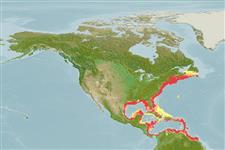Common names from other countries
Environment: milieu / climate zone / depth range / distribution range
Ecologie
Benthopelagisch; diepteverspreiding 0 - 400 m (Ref. 275). Tropical; 10°C - 14°C (Ref. 275), preferred 21°C (Ref. 107945); 50°N - 8°N, 98°W - 53°W (Ref. 275)
Western Atlantic.
Length at first maturity / Size / Gewicht / Leeftijd
Maturity: Lm 15.0 range ? - ? cm Max length : 50.0 cm ML mannelijk/geslacht niet bekend; (Ref. 275); 40 cm ML (female)
Common mantle length: 10.0 to 20.0 cm (Ref. 275, 3722). This is a neritic species found on sandy bottoms and along the water column (Ref. 83938). On coastal surface, epipelagic (Ref. 110525). Spends winter at depths of 100 to 200 m (Ref. 843). Overwinter along the continental shelf in offshore canyons as far south as Cape Hatteras (Ref. 106883).
Life cycle and mating behavior
Geslachtsrijpheid | Voortplanting | Kuitschieten | Eieren | Fecundity | Larven
Members of the class Cephalopoda are gonochoric. Male and female adults usually die shortly after spawning and brooding, respectively. Mating behavior: Males perform various displays to attract potential females for copulation. During copulation, male grasp the female and inserts the hectocotylus into the female's mantle cavity where fertilization usually occurs. Life cycle: Embryos hatch into planktonic stage and live for some time before they grow larger and take up a benthic existence as adults.
Roper, C.F.E., M.J. Sweeney and C.E. Nauen. 1984. (Ref. 275)
Status op de Rode Lijst van het IUCN (Ref. 130435)
Status bij CITES (Ref. 108899)
Not Evaluated
Not Evaluated
Gebruik door de mens
Visserij: commercieel
FAO - Visserij: landings, soortsprofiel | FishSource | Sea Around Us
Tools
Internet-bronnen
Estimates based on models
Preferred temperature
(Ref.
115969): 5.9 - 26.3, mean 19.4 (based on 245 cells).
Weerstandsvermogen
Hoog, minimale populatieverdubbelingstijd minder dan 15 maanden (K=0.59-0.95).
Kwetsbaarheid
Low to moderate vulnerability (26 of 100).
